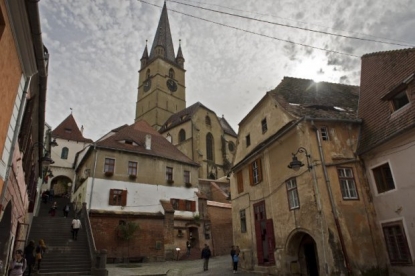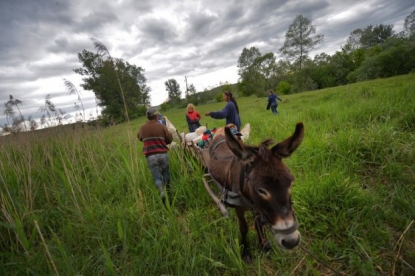Rare moment in spotlight for Romania’s Saxons
ISTANBUL, November 20, 2014 - Likely it was news to many that there even is an ethnic German minority in Romania. A community that proudly dates back its history to the twelfth century, that once numbered hundreds of thousands of people and for long defiantly held onto traditions that had evaporated elsewhere.
But the surprise victory of Sibiu mayor Klaus Iohannis, a member of Romania’s German minority, in the weekend’s presidential elections was a startling reminder of the existence of the community, who are known as the Transylvanian Saxons (Siebenbuerger Sachsen in German). It was also a sign that the community -- which has reduced at least ten fold in size since before World War II -- had defied predictions of its imminent demise.
For me, the victory of Iohannis also brought alive memories of a journey I made in the summer of 1999 when between university and starting work I travelled through Transylvania on a travel scholarship to research the current state of the Saxon community. I had found the idea that a self-contained German community could still exist in modern times, so far from the territory of present day Germany, extraordinary and wanted to find out more.
 Klaus Iohannis adresses the media in Bucharest on November 16, 2014 (AFP Photo / Daniel Mihailescu)
Klaus Iohannis adresses the media in Bucharest on November 16, 2014 (AFP Photo / Daniel Mihailescu)Travelling in Romania at that time was also a way to realise many dreams incubated in anyone who read Patrick Leigh Fermor’s classic travelogue on walking across pre-war Europe, “Between the Woods and the Water”. Eating freshly-made cheese with shepherds while walking to the next village, hearing the howls of wolves in the forest at night, surprise encounters on a journey without maps. The pull of Transylvania goes far beyond the myth of the novel “Dracula”, whose author Bram Stoker never set foot in Romania and a book most admirers of the place like to regard with studied disdain. It’s a true wilderness where bears prowl but also touched by several cultures, German, Hungarian, Romanian, Roma.
From one disaster to another
The Transylvanian Saxon community at that time was still in a state of collective shock, having lurched from one disaster to another over the last half century. While in the 1930s their numbers were estimated at some 300,000, now it was barely 20,000. After World War II, tens of thousands were punished for their identity as Germans by the new pro-Stalin regime and put on trains to camps in Ukraine and the Urals. Many never made it back. With Romania enduring the most extreme interpretation of Communism under Ceausescu, those who could sought to leave. But the biggest wave came with the collapse of Communism from 1989 when almost the entire community left mostly to Germany, which guaranteed Soviet bloc ethnic Germans German citizenship.
 The city center of Sibiu (AFP Photo / Daniel Mihailescu)
The city center of Sibiu (AFP Photo / Daniel Mihailescu)Those who remained were for the most part the elderly, clinging onto traditions but who lamented the passing of an entire way of life. The Saxons trace their origins back to mediaeval times when their ancestors were invited by the Hungarian king to assist with defence and bring their craftsmanship to the region. They upheld a self-contained way of life, keeping up their German folk dress (Tracht), specialising in specific trades and making the church the focus of the community. A 19th century British traveller named Charles Boner -- forgotten at home but well-regarded by the Saxons -- who travelled in Transylvania found a community still locked in a mediaeval time warp. They left left an indelible mark on the Transylvanian landscape, building in the villages astonishingly stout church-fortresses (Kirchenburgen) where their churches stood enclosed behind mighty walls to withstand the Mongol invasions. Many of these structures still stand strong to this day, even in villages where no more Germans live. Seven of them are listed as UNESCO world heritage sites. Capable merchants, the Saxons built up valuable collections of oriental carpets that can still be viewed inside some churches.
Keeping the community alive amid chaos
I think there were doubts then -- amid the chaos of Romania of the late 1990s when it seemed everyone was looking for a way out -- whether the Transylvanian Saxon community would survive at all. Some of the villages were in horrific disrepair and were home to possibly no more than one German couple. In some cases, the keys to the church had been entrusted to a sympathetic local Romanian family, there simply were no Germans left. In summer, those who had emigrated to Germany returned to visit in droves but everyone knew -- it was not the same.
 The Transylvania countryside near the village of Saschiz, in May 2013 (AFP Photo / Daniiel Mihailescu)
The Transylvania countryside near the village of Saschiz, in May 2013 (AFP Photo / Daniiel Mihailescu)Yet even then there was some sign that all hope was not lost. I met several young, impassioned Transylvanian Saxon priests who had resisted the temptation to leave and were working to keep the community alive. There were also teachers from the Saxons’ German schools, which were still among Romania’s most prestigious institutes of learning. At that time, Iohannis was a top school inspector, seen as one of the leading lights of the community and on the verge of an extraordinary breakthrough into politics. In 2000, he won elections to become mayor of his hometown of Sibiu, along with Brasov the great city of this part of Transylvania. Beautiful but crumbling when he took office, he helped transform Sibiu into a thriving centre of trade and tourism. Now he faces the same challenge on a national scale with a big, important state of 20 million which, as Romanians know only too well, is still searching for its full potential and which many still dream of leaving.
What he can achieve for Romania remains to be seen. But hopefully his victory already can jolt people into seeing a different side to this ravishing, complicated country which, too often, is seen only through the prism of tabloid headlines. I doubt if the British tabloids gave Iohannis’ victory the same coverage as they would a Romanian immigrant found cheating on benefits. But maybe this ethnic German can show that Romania -- a Latin nation in a largely Slavic region -- is truly a țară frumoasă -- a beautiful country.
Stuart Williams is an AFP reporter currently based in Istanbul.
 People celebrate Iohannis' victory in downtown Bucharest on November 16, 2014 (AFP Photo / Daniel Mihailescu)
People celebrate Iohannis' victory in downtown Bucharest on November 16, 2014 (AFP Photo / Daniel Mihailescu)

